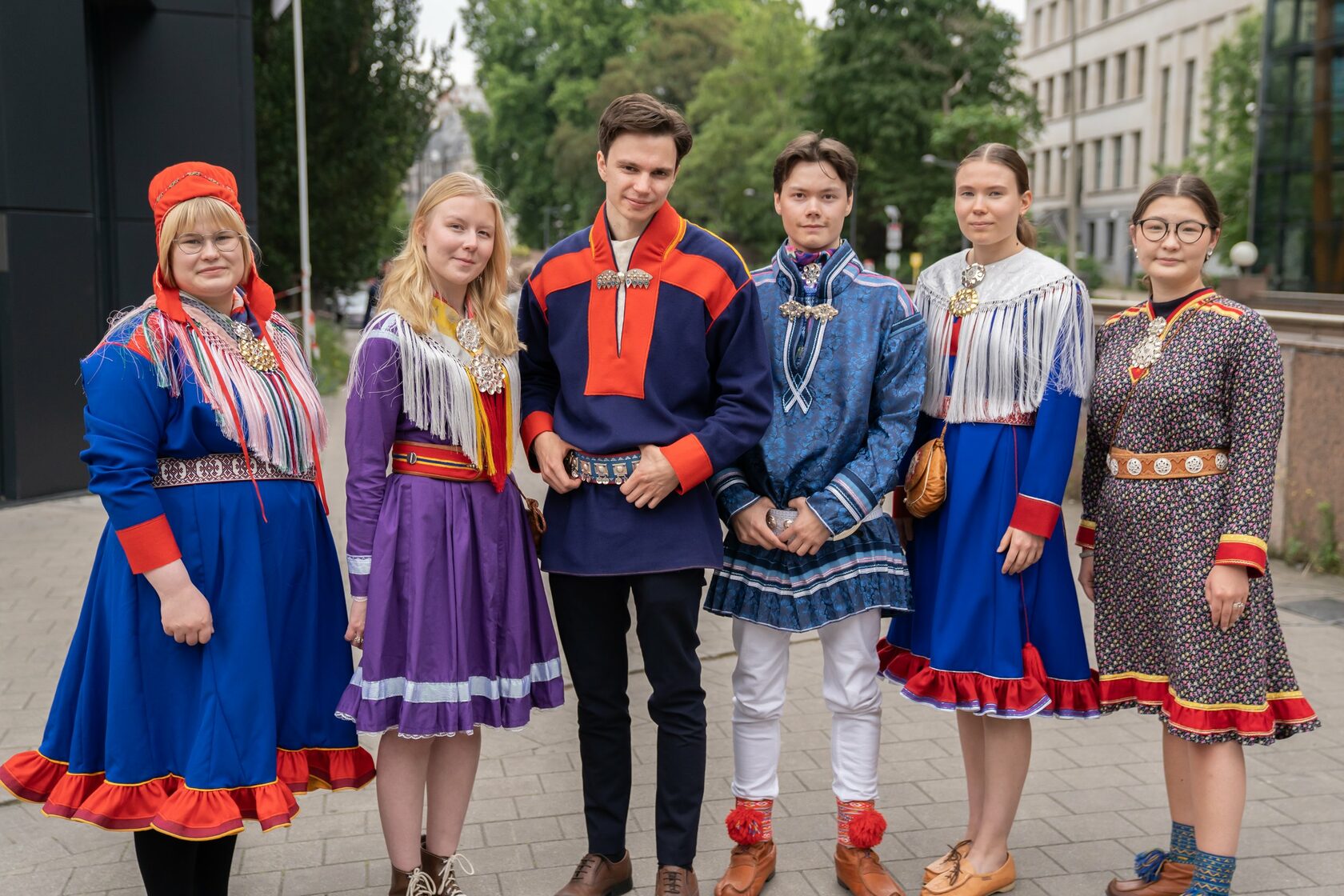


We are here: Public participation is a key issue in the context of minority and Indigenous people's rights. Observing the large underrepresentation of Indigenous people in decision-making processes, how can the EU facilitate the fair and just inclusion and participation of such groups in the political, cultural, social and economic life of the country they live in?
Committee on Civil Liberties, Justice and Home Affairs II
Chaired by Kacper Max Lubiewski (PL). Covered by Jarna Pahlberg (FI)
Executive summary
Although at first glance it might seem that Sámi are well represented in national politics through local Sámi parliaments or nongovernmental organisations, the real conditions of Sámi’s public participation are much more complicated as they continue to struggle with their varying legal status in the region and purely normative privileges, which are often not translated into real-life influence2. Only well-designed cooperation between various regional stakeholders who vary in competencies and tools can ensure a fairer and more inclusive political system for the Sámi. The matter of political disenfranchisement requires a broad understanding of Sámi’s past and trauma towards the public participationce3, beliefs, and customs, which in the past have been proven hard to combine with national laws4, as well as their views on indigenousness and the rights that come with it5. Sámi have been calling upon the EU for years to make Indigenous rights a priority in its policy, but the effects were rather mixed6. Inspiringly, recent protests in Finland show that the matter has never been more relevant to many Sámi7.
The Conversation (2016). Despite gains, Europe’s indigenous people still struggle for recognition. Link
Eva Josefsen (2007). The Saami and the national parliaments: Channels for political influence. Link
Cultural Survival (2002). Environmental Organisations Protest Denial of Saami Herding Rights. Link
Minority Rights Group International (2022). World Directory of Minorities and Indigenous Peoples: Sami. Link
Global Affairs (2020). Contesting the European Union at the “Poles”. Link
Justiceifo.net (2022). In Finland, Sámi rights take central stage in national politics. Link
Listen to the audio Topic Overview

Introduction
The EU has a really sophisticated set of rules, code of conduct when it comes to Indigenous people outside of Europe but not so much when it comes to its own Indigenous people.



& Historical content
Elle Merete Omma
Head of the EU unit of the Saami Council
Head of the EU unit of the Saami Council
"
"
It is difficult to disagree with Elle Merete Omma looking at the controversial record of the EU and its Member States when it comes to human rights protection of the Sámi — Indigenous people to the Sápmi which encompasses land nowadays within the borders of Norway, Sweden, Finland, and Russia. On the one hand, Sámi co-govern Indigenous land through Sámi parliaments — a right rarely enjoyed by Indigenous peoples anywhere in the world8. On the other hand, the electoral process of said parliaments has recently been put into question as it allows non-Sámi inhabitants of the region to vote in them, thus endangering the very reason why they were established in the first place — to ensure Sámi’s representation in regional politics’ decision-making processes9. Similarly, even though public schools in Sápmi receive funding to teach their students about the Sámi’s language and customs10, they are rarely consulted and asked for permission by their national governments to mine natural resources from Sámis’ ancestral land.11 The EU’s policy on Indigenous rights is full of contrasts and contradictions, which has real-life implications for the people who are supposed to be protected by those very laws.
The undoubted success of being formally included in the Arctic Council’s works under a category of Permanent Participants, achieved only because of Sámi and other Indigenous peoples’ determination and bravery, should serve as an inspiration for European society in supporting today’s struggle of Sámi for a more just political system in their homeland.
The undoubted success of being formally included in the Arctic Council’s works under a category of Permanent Participants, achieved only because of Sámi and other Indigenous peoples’ determination and bravery, should serve as an inspiration for European society in supporting today’s struggle of Sámi for a more just political system in their homeland.
One, which is inviting and accommodating to Sámi’s needs, which honours the unique bond they share with Sápmi and one which is fully legitimised by the people whom it is supposed to serve. It is crucial to understand that the fundamental issue behind Sámi’s economic, cultural and social struggles is the one of their political participation on a regional, national and international level. In other words — to fully engage Sámi in the decision-making processes in their Indigenous homeland, is, by extension, to better address their contemporary problems, such as nature conservation or Sámi languages' protection.
Listen to the interview

Interview with Elle Merete Omma, Head of the EU Unit at the Saami Council. Together with the chair of LIBE II they discuss the history of Sámi, problems they face nowadays and the expected path forward to a fairer and more inclusive political system for Indigenous Peoples.
Even though technically Permanent Participants are not members of the Arctic Council, they are allowed to address the meetings, propose supplementary agenda items and propose cooperative activities.
Even though technically Permanent Participants are not members of the Arctic Council, they are allowed to address the meetings, propose supplementary agenda items and propose cooperative activities.
Cultural Survival (2020). Are Indigenous Voices Being Heard Globally?. Link
Justiceifo.net (2022). In Finland, Sámi rights take central stage in national politics. Link
Ministry of Culture and Equality of Norway (2021). Sami cultural policy. Link
Euractiv (2022). Thunberg protests against Sweden iron mine on Sámi land. Link
Key stakeholders

One cannot forget about the Sámi parliaments which enjoy rather high autonomy in the region, being in charge of the protection of Sámi cultural heritage sites, allocation of funds to Sámi language municipalities, and management of grants for teaching purposes13. They also participate in a dialogue with their national governments about environmental protection, although this matter has proved to be especially controversial in the past14. The task of the biggest Sámi-led organisation, the Saami Council, is to advocate for the interests of Sámi in national governments of countries in the region. It gathers and consolidates various Sámi organisations as well as initiates projects in the area of education, culture, and diplomacy. Moreover, it monitors the condition of human rights in the Arctic and lobbies for the establishment of a body representing Sámi in Brussels15.
Sámi parliaments

Even though there is no specifically dedicated EU body to the issue of Indigenous rights, the European Commission is rather active in this policy area. The Treaty on the Functioning of the European Union gives powers to the Union to initiate instruments that contribute to the protection of Indigenous peoples. Additionally, the European Commission holds an Observer’s status in the United Nations and cooperates extensively with the United Nations Permanent Forum on Indigenous Issues and the Human Rights Council within it. The European Commission has also sponsored studies on Indigenous issues in the past and its European Regional Development Fund has been used to fund many projects relevant to Sámi16 17.
European Commission


The Arctic Council
The Arctic Council is arguably the most powerful entity in the region, which consists of 8 member states and 6 Indigenous peoples’ organisations recognised as Permanent Participants, who represent the interests of the Arctic’s Indigenous population. The Arctic Council deals with matters of natural resource extraction, security, environmental protection, and, importantly, the human rights of its Indigenous inhabitants. It initiates its own programmes, facilitates talks between national governments, and provides funding initiatives for regional initiatives12.
Arctic Council (2022). Strategic Plan 2021-2030. Link
Eva Josefsen (2007). The Saami and the national parliaments: Channels for political influence. Link
ElSevier (2022). The impacts of mining on Sámi lands: A knowledge synthesis from three reindeer herding districts. Link
Saami Council (2022). Projects. Link
Saami Council (2022). Projects. Link
United Nations. The EU and Indigenous Peoples’ issue. Link
Measures in place

The legal status of Sámi varies significantly amongst countries in the region — Finnish Constitution and Norway’s Sámi Act recognise Sámi as Indigenous people18, while Swedish law grants them a status of a minority19, as Norway does in the case of Kvens20, interestingly, only Norway has adopted the International Labour Organization’s Indigenous and Tribal Peoples Convention — arguably the most significant international convention concerning Indigenous peoples, which was ratified by 24 countries worldwide and has led to some impressive policy wins abroad, most notably in Chile21 22.
Furthermore, Norway’s Finnmark Act of 2005 transferred about 96% of the area in Finnmark county to the Sámi inhabitants. The area is managed by Finmark Estate, half of which board members are elected by the Sámi Parliament in Norway. However, Finmark Estate’s competencies do not include fishing rights in saltwater, mining, or oil rights23. Importantly, the establishment of an analogical body was proposed in the countries of Troms and Nordland in Norway24 What is more, in 2016, the Indigenous Peoples’ Secretariat submitted a report to the Arctic Council, suggesting that Permanent Participants do not get satisfactory funding for their own initiatives25. As a result, the Álgu Fund was established, the interests of which will be distributed annually between Permanent Participant organisations. However, the fund has not yet reached its financial goal of US$30 million and doesn’t operate at its full capacity yet26.
Furthermore, Norway’s Finnmark Act of 2005 transferred about 96% of the area in Finnmark county to the Sámi inhabitants. The area is managed by Finmark Estate, half of which board members are elected by the Sámi Parliament in Norway. However, Finmark Estate’s competencies do not include fishing rights in saltwater, mining, or oil rights23. Importantly, the establishment of an analogical body was proposed in the countries of Troms and Nordland in Norway24 What is more, in 2016, the Indigenous Peoples’ Secretariat submitted a report to the Arctic Council, suggesting that Permanent Participants do not get satisfactory funding for their own initiatives25. As a result, the Álgu Fund was established, the interests of which will be distributed annually between Permanent Participant organisations. However, the fund has not yet reached its financial goal of US$30 million and doesn’t operate at its full capacity yet26.

The Indigenous People's Secretariat assists Permanent Participants in presenting their cases before the Arctic Council and coordinates communication between them.
The Álgu Fund is a charitable foundation led by different indigenous peoples' organisations aiming to support Arctic research and cultural initiatives of the indigenous communities.
Eva Josefsen (2007). The Saami and the national parliaments: Channels for political influence. Link
Swedish Institute (2022). With a culture that remains strong, some 20,000 Sami live in Sweden. Link
Fenno-Ugria (2021). Kvens. Link
Nettheim, Garth (2002). Indigenous Peoples and Governance Structures: A Comparative Analysis of Land and Resource Management Rights.
Ministry of Justice and Public Security of Norway (2006). Act relating to legal relations and management of land and natural resources in Finnmark. Link
NRK (2007). New owners of Troms and Nordland. Link
Library of Parliament (2022). The Arctic Council: The Involvement of Indigenous Peoples. Link
The Arctic Institute (2019). Form and Function: The Future of the Arctic Council. Link
White & Case (2022).Supreme Court of Justice withdraws mining concessions for lack of community consultations. Link
Many promising projects are conducted by Sámi themselves; especially through the Saami Council. For example, in 2019, the Saami Council initiated the Filling the EU-Sápmi knowledge gaps project, of which the overall aim “is to strengthen the relationship between Sápmi and the EU, through creating a knowledge platform on EU-Sámi, a pilot Sámi Week in Brussel and an establishment of an EU-Sámi think-tank of Sámi experts”. Additionally, the EU-Sámi Youth Idea Lab was inaugurated earlier in 2022, which aims to “raise awareness among Sámi Youth about EU policies and give youth the chance to engage actively and participate in finding solutions to making their voices heard in the EU” according to its organisers27.


Saami Council (2022). Projects. Link
Fundamental conflicts

Eva Josefsen (2007). The Saami and the national parliaments: Channels for political influence. Link
Global Affairs (2020). Contesting the European Union at the “Poles”: a multi-level analysis of contestation of the EU’s presence in the Arctic. Link
Eva Josefsen (2007). The Saami and the national parliaments: Channels for political influence. Link
Johanna Zilliacus (2022). A colonial history of social exclusion of indigenous Sámi in Finland. Link
Euractiv (2022). Thunberg protests against Sweden iron mine on Sámi land. Link
Global Affairs (2020). Contesting the European Union at the “Poles”: a multi-level analysis of contestation of the EU’s presence in the Arctic. Link
Justiceifo.net (2022). In Finland, Sámi rights take central stage in national politics. Link
The most widely-used definition of indigenousness is the one proposed by the United Nations. Link
The Barents Observer (2017). Kven peoples will be examined. Link
Outlook

It is clear that the matter of Sámi’s public participation is one of incredible complexity and seriousness. It must be considered within a context of centuries-long oppression faced by the Sámi and their distrust towards national, and political structures. Sámi’s problems vary depending on where they live, just as accessible to them tools of political influence do. An efficient solution must propose a factual (and not purely normative) change, address the EU’s stance on Indigenous rights, establish a layered and structural dialogue with Sámi and standardise their rights wherever they live. Equally important to “what should Sámi public participation look like?” is to ask “what hinders their participation in the status quo?” — After all, only looking back at past mistakes such as the Alta controversy or aforementioned Sámi protests in Finland will we be able to address the core issue lying behind Sámi’s political disenfranchisement.
Download pdf

In case you need it


We gathered all the essential information of your TO is a PDF document for your convenience.
Click on the button below to download your Topic Overview, but be aware that the PDF document might not contain all the information from the website (pictures, videos, visuals, etc).
Click on the button below to download your Topic Overview, but be aware that the PDF document might not contain all the information from the website (pictures, videos, visuals, etc).
The PDF document is not available at the moment, but you'll be able to download it in the upcoming days!
Term ''Alta controversy'' refers to series of mass protests and acts of civil disobedience in the late 1970s and early 1980s concerning the construction of a hydroelectric power plant in the Alta River in Finnmark, Northern Norway, which would have flooded Sámi village of Masi.
Motion for a resolution

Submitted by:
Athanasia Balasi (GR), Alessia Dos Reis Neto (LX), Benjamin Huyghe (BE), Alexander Kabranski (BG), Eiler Kongsrud (NO), Elena Macura (AU), Adil Mammadov (AZ), Elena Martirosyan (AM), Rian Mulcahy (IE), Lemet Máheli Gaup Myrnes (SA), Klára Nováková (CZ), Anna Quinaux (HR), Barbara Warembier (PL), Kacper Max Lubiewski (Chairperson, PL)
Athanasia Balasi (GR), Alessia Dos Reis Neto (LX), Benjamin Huyghe (BE), Alexander Kabranski (BG), Eiler Kongsrud (NO), Elena Macura (AU), Adil Mammadov (AZ), Elena Martirosyan (AM), Rian Mulcahy (IE), Lemet Máheli Gaup Myrnes (SA), Klára Nováková (CZ), Anna Quinaux (HR), Barbara Warembier (PL), Kacper Max Lubiewski (Chairperson, PL)
The European Youth Parliament aims to provide the Sámi and other Indigenous People of the Arctic with adequate political representation to ensure their full inclusion in all decision-making processes on issues which concern them. Furthermore, aspiring to profoundly empower and support the Sámi people, it strives to establish an environment of transnational cooperation between the Arctic States of the Sápmi based on respect towards their traditional values and ways of living,
A. Deeply conscious of the continued indolence and ineffectiveness of the Arctic States in resolving the issues most relevant to the Sámi,
B. Gravely concerned by the frequency of cases when Sámi values and livelihoods are being compromised over national governments’ ambitions for profit,
C. Noting with deep regret that national governments of the Arctic States routinely implement mining and environmental policies in the Sápmi without consultations with the Sámi population living there,
D. Alarmed by the lack of an institutionalised Sámi political representation within the EU legislative process concerning indigenous issues,
E. Taking into account the lack of trust Sámi put in their respective national governments in regard to their promises or policy proposals concerning Sápmi,
F. Emphasising the scarcity of EU-organised youth programmes inclusive and accessible to the Indigenous youth of the Arctic,
G. Observing with great concern that certain groups within the Sámi community, such as women, queer people, and disabled people, are even more prone to discrimination and political exclusion than other Sámi,
H. Deploringthelackofoneagreed-upondefinitionofIndigenousnessamongtheArcticCounciland the European Commission, further leading to the exclusion of Indigenous Peoples from measures aimed at protecting Indigenous rights,
I. Alarmed by non-Sámi citizens being allowed to vote and run as representatives in the Sámi Parliament in Finland,
J. Pointing out the political repression Sámi living in Russia face for advocating for their rights, with punishments such as imprisonment or fines occurring,
K. Welcoming the Arctic Council’s development of the Sámi Arctic Strategy, aiming to further the competencies and the political leverage of the Saami Council;
A. Deeply conscious of the continued indolence and ineffectiveness of the Arctic States in resolving the issues most relevant to the Sámi,
B. Gravely concerned by the frequency of cases when Sámi values and livelihoods are being compromised over national governments’ ambitions for profit,
C. Noting with deep regret that national governments of the Arctic States routinely implement mining and environmental policies in the Sápmi without consultations with the Sámi population living there,
D. Alarmed by the lack of an institutionalised Sámi political representation within the EU legislative process concerning indigenous issues,
E. Taking into account the lack of trust Sámi put in their respective national governments in regard to their promises or policy proposals concerning Sápmi,
F. Emphasising the scarcity of EU-organised youth programmes inclusive and accessible to the Indigenous youth of the Arctic,
G. Observing with great concern that certain groups within the Sámi community, such as women, queer people, and disabled people, are even more prone to discrimination and political exclusion than other Sámi,
H. Deploringthelackofoneagreed-upondefinitionofIndigenousnessamongtheArcticCounciland the European Commission, further leading to the exclusion of Indigenous Peoples from measures aimed at protecting Indigenous rights,
I. Alarmed by non-Sámi citizens being allowed to vote and run as representatives in the Sámi Parliament in Finland,
J. Pointing out the political repression Sámi living in Russia face for advocating for their rights, with punishments such as imprisonment or fines occurring,
K. Welcoming the Arctic Council’s development of the Sámi Arctic Strategy, aiming to further the competencies and the political leverage of the Saami Council;
1. Encourages the Arctic States to initiate formal, broad and legally-binding public consultations between their respective government and Sámi locals once a policy affecting the Sápmi is proposed;
2. Urges the Saami Council, the European Commission, and the Arctic Council to organise annual summits to discuss the development of issues Indigenous Peoples of the Arctic face, such as but not limited to climate change, environment protection and agricultural policies;
3. Calls upon the Arctic Council and European Commission to adopt the European Environment Agency’s definition of indigenousness in their works;
4. Requests the European Youth Foundation to fund and co-organise initiatives aimed at providing mentorship to Indigenous youth in regards to the public participation;
5. Appeals to the International Work Group for Indigenous Affairs to expand its area of work to Russia with an aim of lobbying for an establishment of an Indigenous Peoples Parliament in the region of Murmansk;
6. Asks the Arctic States to implement a quota for Indigenous representatives in their national parliaments, enumerated by the percentage of Indigenous population living in the respective country;
7. Calls upon Nordic States to organise demographically representative Sámi citizen assemblies together with the Saami Council in cases of highly controversial matters;
8. Encourages the Saami Council and European Commission to establish a joint Audit Committee focused on supervising and evaluating ongoing projects, as well as past cooperation between them making its results available to the public;
9. Recommends the Arctic States to only enact policies affecting the Sápmi and Sámi only if said policies have been approved by a simple majority in a Sámi Parliament;
10. Invites the Saami Council to establish a Saami Diversity Council which would consist of relevant NGOs’ representatives and overlook the inclusion of Sámi individuals with other marginalised identities in decision-making processes in countries they live in;
11. Strongly urges the European Commission to make the up-to-date reports of its participation in the meetings and the regular work of the Arctic Council publicly available;
12. Suggests Finland to reform its electoral process to the Sámi Parliament in Finland so that only Finnish citizens with least one Sámi grandparent, are allowed to vote and be elected in them;
13. Calls upon Sweden and Finland to ratify the International Labour Organization’s Indigenous and Tribal Peoples Convention.
2. Urges the Saami Council, the European Commission, and the Arctic Council to organise annual summits to discuss the development of issues Indigenous Peoples of the Arctic face, such as but not limited to climate change, environment protection and agricultural policies;
3. Calls upon the Arctic Council and European Commission to adopt the European Environment Agency’s definition of indigenousness in their works;
4. Requests the European Youth Foundation to fund and co-organise initiatives aimed at providing mentorship to Indigenous youth in regards to the public participation;
5. Appeals to the International Work Group for Indigenous Affairs to expand its area of work to Russia with an aim of lobbying for an establishment of an Indigenous Peoples Parliament in the region of Murmansk;
6. Asks the Arctic States to implement a quota for Indigenous representatives in their national parliaments, enumerated by the percentage of Indigenous population living in the respective country;
7. Calls upon Nordic States to organise demographically representative Sámi citizen assemblies together with the Saami Council in cases of highly controversial matters;
8. Encourages the Saami Council and European Commission to establish a joint Audit Committee focused on supervising and evaluating ongoing projects, as well as past cooperation between them making its results available to the public;
9. Recommends the Arctic States to only enact policies affecting the Sápmi and Sámi only if said policies have been approved by a simple majority in a Sámi Parliament;
10. Invites the Saami Council to establish a Saami Diversity Council which would consist of relevant NGOs’ representatives and overlook the inclusion of Sámi individuals with other marginalised identities in decision-making processes in countries they live in;
11. Strongly urges the European Commission to make the up-to-date reports of its participation in the meetings and the regular work of the Arctic Council publicly available;
12. Suggests Finland to reform its electoral process to the Sámi Parliament in Finland so that only Finnish citizens with least one Sámi grandparent, are allowed to vote and be elected in them;
13. Calls upon Sweden and Finland to ratify the International Labour Organization’s Indigenous and Tribal Peoples Convention.




